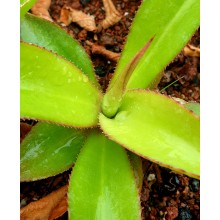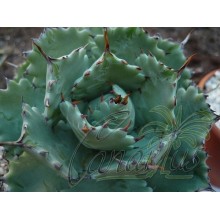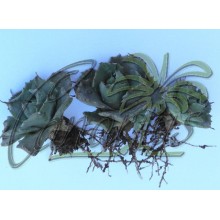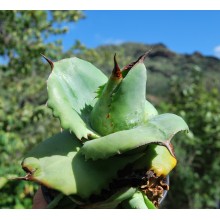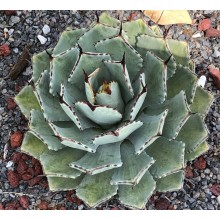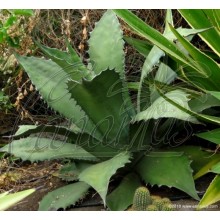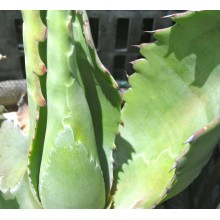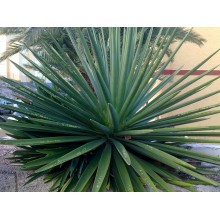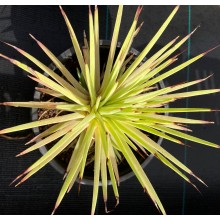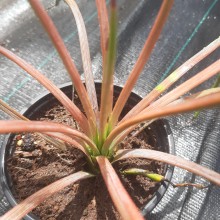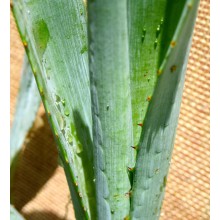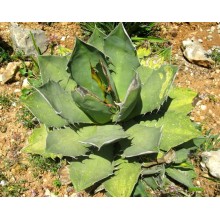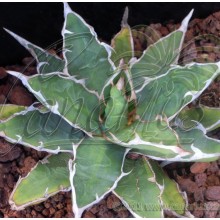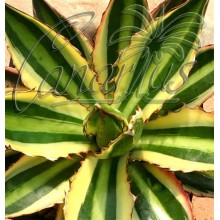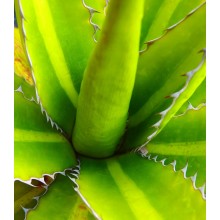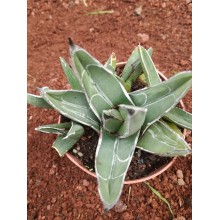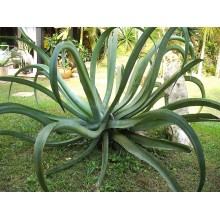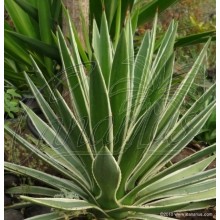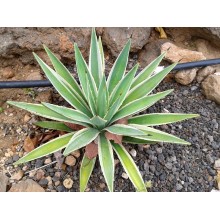Tutte le piante Ci sono 1882 prodotti.

Se vi piacciono le piante esotiche, allora sei nel posto giusto. Canarius offre le piante esotiche difficile da trovare che sono raramente disponibili in centri di giardinaggio. Il nostro negozio ha specie naturali e rari ibridi. Offriamo piante esotiche provenienti dalle Isole Canarie.
Gli ordini sono inviati a ovunque in Europa e anche in tutto il mondo. I pacchi raggiungeranno la vostra casa in pochi giorni dopo la spedizione (ma abbiamo bisogno anche alcuni giorni per l'elaborazione). Non esitate a contattarci se avete domande.
Sotto-categorie
-
Succulente
I deserti del mondo e le zone secche ospitano le piante più interessanti. Canarius offre una selezione crescente di piante succulente di massima qualità, perché sono coltivate all'aperto, in pieno sole delle Isole Canarie.
I succulente o "piante grasse" sono specie di ritenzione di acqua, adattate alle condizioni di asciutto. Loro accumulano succum (succo, acqua) nelle loro foglie, steli o radici, e spesso mostrano un aspetto robusto e carnoso.
-
Esotiche
Le piante esotiche sono specie provenienti da altre parti del mondo, e di solito hanno le qualità ornamentali: una vegetazione lussureggiante, fiori colorati, forme insolite... Qui è possibile trovare una grande varietà di piante esotiche: da bromeliacee e Heliconias, fino a palme e piante d'appartamento.
Le piante esotiche non hanno un uso particolare. I collettori acquistano questo tipo di piante per la loro rarità, per la decorazione interna o esterna, a seconda delle loro caratteristiche.
-
Da frutto & Per la salute
Le piante da frutto, erbe e piante medicinale sono concentrati su come ottenere una salute migliore. In questo contenuto della sezione, ogni tipo di pianta produce effetti salutari, entrambi alberi da frutto (Feijoa, Ananas, Fina Jete...) e piante per la salute, come Graviola, Aloe vera, Callisia fragrans... Nel normale metabolismo di tutti gli esseri viventi, l'organismo produce delle sostanze nutritive da latenti per l'ambiente; alcune di queste sostanze chimiche sono parte del processo in tutte le specie. Normalmente, i composti utili sono concentrati in alcune dei sue parti: foglie, semi, fiori...
-
Speciale
Su canarius.com cerchiamo di rimuovere i limiti nel campo della botanica. Sul nostro negozio online cerchiamo di facilitare l'acquisto / vendita di piante di tutto il mondo. Per questo motivo, coltiviamo piante di tutto il mondo, specie più comuni ed anche piante più particolari, come si può vedere in questa sezione.
-
Agave pendula
Agave pendula
Quite different and attractive, this agave has few leaves and they are fleshy and soft, with a pale green colour, reminiscent of Agave attenuata.
24,30 € -
Agave potatorum
Agave potatorum
14-18 cm pot, bare rooted - Small to medium sized, compact Agave with embossed glaucous leaves. Margins are undulate and armed with reddish-brown spines. It is a mountain species from southern Mexico, found at 1300 to 2300 m (4500 to 7500 ft.).
11,30 € -
Agave potatorum 'Shoji Rajin'
Agave potatorum 'Shoji Rajin'
Agave of 5-7 cm (2-3 in). Dwarf Japanese selection of Agave potatorum. It is very compact and grows only to 5-10 cm (2-4") in diameter. Leaves are wide, thick and dusty blue, with few spines.
12,00 € -
Agave potatorum 'Short Form'
Agave potatorum 'Short Form'
Small sized, compact Agave with short rounded leaves. This selection is especially attractive with a lovely leaf shape. It is easy to grow and hardy, just as the more widespread forms of Agave potatorum, with the typical glaucous leaves with maroon-black spines.
24,50 € -
Agave potatorum ‘Kichiokan’
Agave potatorum ‘Kichiokan’
14-18 cm pot, bare rooted - Small to medium sized, compact Agave with embossed glaucous leaves. Margins are undulate and armed with reddish-brown spines. It is a mountain species from southern Mexico, found at 1300 to 2300 m (4500 to 7500 ft.).
23,40 € -
Agave salmiana var. ferox
Agave salmiana var. ferox
10 cm cutting. A giant in the genus, the ferocious classic Agave ferox can take some frost and snow.
11,70 € -
Agave sisalana
Agave sisalana
NEW - 14-18 cm. This is a millenary crop plant grown for fibres named sisal. It originated in Mexico, Chiapas, and is widelycultivated elsewhere. It is probably a sterile cultivar derived from A. vivipara.
11,80 € -
Agave stricta 'nana'
Agave stricta 'nana'
This small agave has become very popular during the past years because of a lot of reasons. It is an official beauty, spineless except at the tip, with green-blue leaves.
20,80 € -
Agave Tenuifolia
Agave Tenuifolia
Agave tenuifolia features slender tufts of flexible, arching, blue-green foliage. Lax rosettes form loose clumps.
14,70 € -
Agave tequilana
Agave tequilana
The famous tekila drink is produced with this species with grey-blue leaves. Agave tequilana is only known in cultivation, and was never found in the wild, but it was possibly originally native to Jalisco in Mexico. It is a large plant with straight grey-blue leaves. It is hardy to light frost, to about - 3 C.
12,30 € -
Agave triangularis
Agave triangularis
NEW !- Olive-green leaves, finely asperous, with a broad paler band running down the center. Native to an arid calcareous region in Teuhuacan, Puebla, at 1650-1950 m elevation. Slow growing, attaining 50-80 cm in diameter. It will stay smaller in pots.
17,20 € -
Agave univittata 'Quadricolor'
Agave univittata 'Quadricolor'
20-22 cm diameter. Exciting garden selection of a small, frost-hardy agave. Rosettes are compact, tidy and four-coloured (quadri-color). This variegated cultivar will survive - 5 C (23 F) and even less if kept dry.
15,80 € -
Agave univittata 'Quadricolor'- LARGE
Agave univittata 'Quadricolor'- LARGE
20-22 cm diameter. Exciting garden selection of a small, frost-hardy agave. Rosettes are compact, tidy and four-coloured (quadri-color). This variegated cultivar will survive - 5 C (23 F) and even less if kept dry.
39,20 € -
Agave univittata 'Splendida'
Agave univittata 'Splendida'
This small, frost-hardy agave is a non-hybrid clone selected in cultivation, with enhanced colours. Leaves are darker, with a paler central stripe, all is glossy and the leaf margins are almost white. It is frost resistant to -15 C or more if kept dry!
27,50 € -
Agave victoriae-reginae 'Ferdinandi-regis'
Agave victoriae-reginae 'Ferdinandi-regis'
Until recently, Agave ferdinandi-regis was considered a fully different species. It is a very elegant Agave, less compact than victoriae-reginae with dark reddish brown edges (not silvery). It is solitary or very slow to sucker, globose, slow growing up to 45 cm.
17,20 € -
Agave vilmoriniana
Agave vilmoriniana
A totally different spineless Agave unlike any other, with a smooth spreading rosette of elegantly curving leaves. Its unmistakeable "octopus shape" is a highlight both in a succulent collection and in the exotic garden.
26,40 € -
Agave vivipara 'marginata'
Agave vivipara 'marginata'
13-17 cm. This is a popular species, commonly seen in Mexican and Caribbean gardens. Fantastic shape with olive-green leaves with white margins and black spines.
11,40 €
Al momento ci sono pochi prodotti in questa categoria Tutte le piante




















